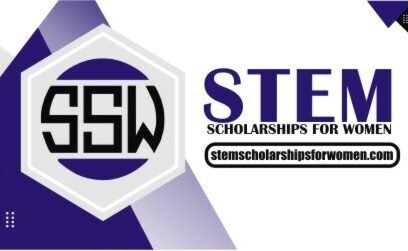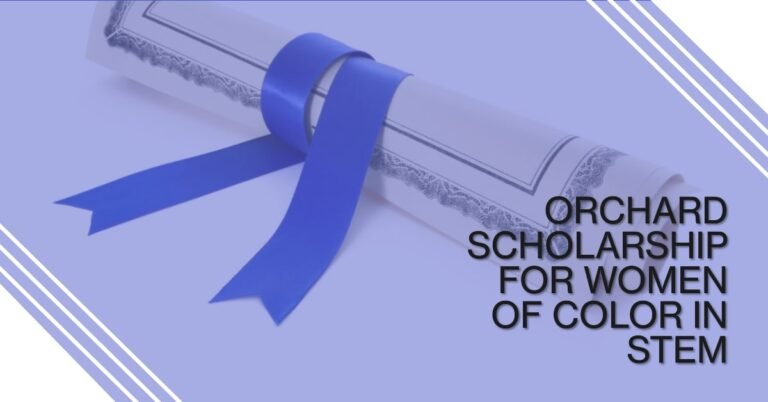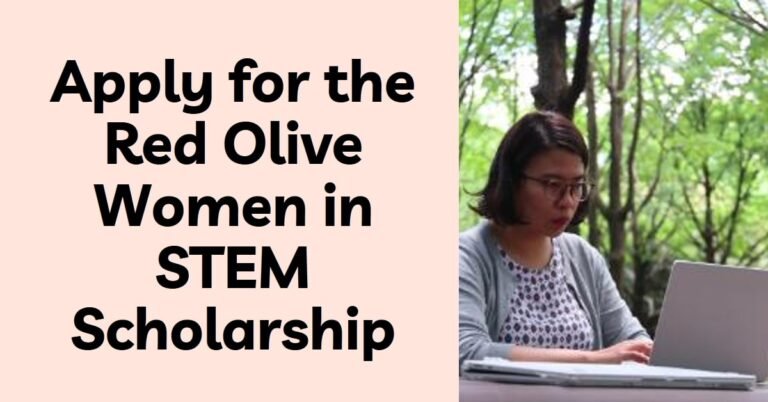How to Apply for the NSF Graduate Research Fellowship STEM Scholarship for Women
Are you a woman interested in pursuing a research-based master’s or doctoral degree in science, technology, engineering, or mathematics (STEM) or STEM education? Do you want to receive financial support, professional development, and recognition for your potential as a future STEM leader? If so, you should consider applying for the NSF Graduate Research Fellowship STEM Scholarship for Women, a highly competitive and prestigious award offered by the National Science Foundation (NSF).
The NSF Graduate Research Fellowship Program (GRFP) is one of the oldest and most respected programs in the United States that supports outstanding graduate students in STEM fields. The GRFP recognizes and supports individuals who have demonstrated their potential for significant research achievements in STEM or STEM education. The GRFP provides three years of support over a five-year fellowship period for the graduate education of individuals who have demonstrated their potential for significant research achievements in STEM or STEM education.
The GRFP aims to help ensure the quality, vitality, and diversity of the scientific and engineering workforce of the United States. The program encourages applications from women, minorities, persons with disabilities, and veterans, in order to broaden and diversify those participating in science and engineering.
In this blog post, we will provide you with all the information you need to know about the NSF Graduate Research Fellowship STEM Scholarship for Women, including:
- What is the NSF Graduate Research Fellowship and what are its objectives?
- Who is eligible to apply for the scholarship and what are the requirements?
- How much is the scholarship worth and what are the benefits?
- What are the available courses and fields of study?
- When is the deadline to apply for the scholarship and how to submit the application?
- Where can the applicants find more information and contact details?
We will also answer some frequently asked questions and provide you with some tips and resources to help you prepare a successful application. By the end of this blog post, you will have a clear idea of how to apply for the NSF Graduate Research Fellowship STEM Scholarship for Women and why you should not miss this opportunity.
What is the NSF Graduate Research Fellowship and what are its objectives?
The NSF Graduate Research Fellowship Program (GRFP) was established in 1952, with the goal of encouraging basic scientific research and ensuring comprehensive, competitive research programs for U.S. students. Since then, the NSF has funded over 46,500 Graduate Research Fellowships out of over 500,000 applicants. Many former graduate fellows have gone on to become Nobel laureates and members of the National Academy of Sciences. Some well-known NSF GRFP alumni include Eric Cornell, Steven Chu, Jennifer Richeson, Sergey Brin, Amy Mainzer, Steven Levitt, Burton Richter, and John C. Mather
The purpose of the NSF Graduate Research Fellowship Program (GRFP) is to help ensure the quality, vitality, and diversity of the scientific and engineering workforce of the United States. The program recognizes and supports outstanding graduate students who are pursuing full-time research-based master’s and doctoral degrees in science, technology, engineering, and mathematics (STEM) or in STEM education. The GRFP provides three years of support over a five-year fellowship period for the graduate education of individuals who have demonstrated their potential for significant research achievements in STEM or STEM education
The objectives of the GRFP are to:
- Select, recognize, and financially support individuals early in their careers with the demonstrated potential to be high achieving scientists and engineers.
- Broaden participation in science and engineering of women, underrepresented minorities, persons with disabilities, and veterans.
- Enhance the quality, diversity, and innovation of the U.S. science and engineering enterprise.
- Encourage the best and most promising U.S. citizens to pursue graduate study and research careers in STEM or STEM education.
- Provide opportunities for Fellows to acquire additional skills and engage in professional development activities outside their chosen fields of study.
- Increase the competitiveness and global engagement of the U.S. STEM workforce
Who is eligible to apply for the scholarship and what are the requirements?
To be eligible for the NSF Graduate Research Fellowship STEM Scholarship for Women, you must meet all of the following eligibility criteria by the application deadline:
- Be a U.S. citizen, national, or permanent resident
- Intend to enroll or be enrolled in a research-based master’s or doctoral degree program in an eligible Field of Study in STEM or STEM education
- Have never previously accepted a Graduate Research Fellowship
- If previously offered a Graduate Research Fellowship, have declined by the acceptance deadline
- Have never previously applied to GRFP while enrolled in a graduate degree program
- Have never earned a doctoral or terminal degree in any field
- Have never earned a master’s or professional degree in any field, or completed more than one academic year in a graduate degree-granting program, unless (i) returning to graduate study after an interruption of two or more consecutive years immediately preceding the application deadline, and; (ii) not enrolled in a graduate degree program at the application deadline
- Not be a current NSF employee
The GRFP supports over 100 subfields of STEM and STEM education. You can find the list of eligible fields of study here
The GRFP is open to applicants in their first year of graduate study and to individuals who have completed no more than 12 months of full-time graduate study. Applicants who have completed more than 12 months of graduate study must have had an interruption in graduate study of at least two consecutive years prior to the application deadline and have not engaged in any graduate coursework during the interruption. Applicants who have earned a joint bachelor’s-master’s degree must enroll in a PhD program in the semester immediately following graduation to be eligible to apply for the GRFP.
The GRFP does not have any specific academic requirements or prerequisites. However, applicants are expected to demonstrate their potential for significant research achievements in STEM or STEM education based on their previous experiences, academic achievements, and future plans. Applicants are also expected to address the broader impacts of their research and education activities on society and the world.
How much is the scholarship worth and what are the benefits?
The NSF Graduate Research Fellowship STEM Scholarship for Women is one of the most generous and prestigious awards for graduate students in STEM fields. The fellowship provides the following benefits:
- A three-year annual stipend of $37,000
- A $16,000 cost of education allowance for tuition and fees (paid to the institution)
- Opportunities for international research and professional development through the Graduate Research Opportunities Worldwide (GROW) and the Graduate Research Internship Program (GRIP)
- Access to supplemental funding to sustain research while on medical deferral (e.g. maternity/paternity leave)
- Access to XSEDE Supercomputer resources
- Freedom to conduct your own research at any accredited U.S. institution of graduate education you choose
- Recognition as an NSF Graduate Research Fellow
The NSF Graduate Research Fellowship STEM Scholarship for Women not only provides financial support, but also opens up many doors for your academic and professional career. As an NSF Graduate Research Fellow, you will:
- Join a network of over 46,500 alumni who are leaders and innovators in science and engineering
- Receive mentoring and guidance from NSF program officers and other experts in your field
- Enhance your skills and knowledge through workshops, webinars, and online resources
- Gain access to exclusive job opportunities and internships with federal agencies and national laboratories
- Increase your visibility and recognition as a potential candidate for prestigious awards and honors
- Contribute to the advancement of science and engineering and the public good.
What are the available courses and fields of study?
The NSF Graduate Research Fellowship STEM Scholarship for Women supports graduate students pursuing research-based master’s and doctoral degrees in STEM or STEM education fields within NSF’s mission. The NSF supports research in all areas of science and engineering, as well as interdisciplinary and convergent research that integrates different disciplines and perspectives.
The NSF has identified 10 Big Ideas for Future NSF Investments, which are long-term research and process ideas that identify areas for future investment at the frontiers of science and engineering. The 10 Big Ideas are:
- Harnessing the Data Revolution
- The Future of Work at the Human-Technology Frontier
- Navigating the New Arctic
- Windows on the Universe: The Era of Multi-Messenger Astrophysics
- The Quantum Leap: Leading the Next Quantum Revolution
- Understanding the Rules of Life: Predicting Phenotype
- Mid-scale Research Infrastructure
- NSF 2026: NSF’s Vision for the Future
- Growing Convergence Research
- NSF INCLUDES: Enhancing Science and Engineering through Diversity
The NSF encourages applicants to align their research topics with these Big Ideas, as well as with other NSF priority areas and cross-cutting programs. However, applicants are free to propose any research topic that falls within the scope of NSF-supported fields.
The NSF has also designated 10 STEM fields of study for the GRFP, which are broad categories that encompass various subfields and disciplines. The 10 STEM fields of study are:
- Chemical Sciences
- Computer and Information Science and Engineering
- Engineering
- Geosciences
- Life Sciences
- Materials Research
- Mathematical Sciences
- Physics and Astronomy
- Psychology
- Social Sciences
You can find the list of eligible subfields and disciplines within each STEM field of study here.
When is the deadline to apply for the scholarship and how to submit the application?
The NSF Graduate Research Fellowship STEM Scholarship for Women has an annual application cycle, with different deadlines for different STEM fields of study. The application deadlines for the 2023-2024 academic year are:
- October 18, 2023: Geosciences, Life Sciences
- October 19, 2023: Computer and Information Science and Engineering, Engineering, Materials Research
- October 21, 2023: Psychology, Social Sciences, STEM Education and Learning
- October 22, 2023: Chemistry, Mathematical Sciences, Physics and Astronomy
The application process for the NSF Graduate Research Fellowship STEM Scholarship for Women is online and consists of the following steps:
- Register as an applicant on the NSF FastLane website and create a profile with your personal and academic information
- Complete the GRFP application form and upload the required documents, including:
- Three letters of reference from faculty members or other individuals who can evaluate your potential for graduate study and research
- Transcripts from all institutions attended for undergraduate and graduate study
- A personal statement that describes your background, personal experiences, and career goals, and how they relate to the broader impacts of the GRFP
- A research statement that describes your proposed plan of research, its intellectual merit and broader impacts, and how it aligns with NSF’s mission and priorities
- Submit your application by the deadline for your field of study
- Receive an email confirmation of your submission and a unique application ID number
- Wait for the notification of the results, which are usually announced in early April of the following year
The NSF Graduate Research Fellowship STEM Scholarship for Women is a highly competitive and selective program, with an average acceptance rate of around 15%. The applications are reviewed by panels of experts in each STEM field of study, who evaluate the applicants based on the following criteria:
- Intellectual Merit: The potential of the applicant to advance knowledge in STEM or STEM education based on their academic achievements, research skills, creativity, and originality
- Broader Impacts: The potential of the applicant to benefit society and contribute to the achievement of specific, desired societal outcomes based on their personal experiences, professional activities, and future plans
The NSF Graduate Research Fellowship STEM Scholarship for Women is a great opportunity for women who aspire to become leaders and innovators in STEM fields. If you are eligible and interested, you should start preparing your application as soon as possible, as it requires a lot of time and effort to craft a compelling and convincing personal and research statement. You should also seek feedback and advice from your mentors, advisors, and peers, as well as from former or current NSF Graduate Research Fellows. You can find some helpful tips and resources on how to write a successful application here.
Where can the applicants find more information and contact details?
If you want to learn more about the NSF Graduate Research Fellowship STEM Scholarship for Women, you can visit the official website of the program, where you can find detailed information about the eligibility criteria, application process, benefits, fields of study, and FAQs. You can also download the program solicitation, which is the official document that outlines the rules and guidelines for the program.
If you have any questions or concerns about the program or your application, you can contact the NSF GRFP Help Center, which is available Monday to Friday, 8:30 AM to 5:30 PM Eastern Time, by phone at 1-866-NSF-GRFP (1-866-673-4737) or by email at info@nsfgrfp.org. You can also contact the NSF GRFP Program Directors, who are responsible for overseeing the administration and management of the program, by email at grfp@nsf.gov.
Frequently Asked Questions
Here are some common questions and answers about the NSF Graduate Research Fellowship STEM Scholarship for Women:
Q: Can I apply for the NSF Graduate Research Fellowship STEM Scholarship for Women if I am not a U.S. citizen, national, or permanent resident?
A: No, you must be a U.S. citizen, national, or permanent resident to be eligible for the program. However, there are other NSF programs that support international students, such as the International Research Experiences for Students (IRES) and the Partnerships for International Research and Education (PIRE). You can find more information about these programs here.
Q: Can I apply for the NSF Graduate Research Fellowship STEM Scholarship for Women if I am already enrolled in a graduate program?
A: Yes, you can apply for the program if you are in your first year of graduate study or if you have completed no more than 12 months of full-time graduate study. However, if you have completed more than 12 months of graduate study, you must have had an interruption in graduate study of at least two consecutive years prior to the application deadline and have not engaged in any graduate coursework during the interruption.
Q: Can I apply for the NSF Graduate Research Fellowship STEM Scholarship for Women more than once?
A: No, you can only apply for the program once, either as an undergraduate senior or as a first-year graduate student. If you are offered the fellowship, you must accept or decline it by the acceptance deadline. If you decline the fellowship, you cannot reapply for the program.
Q: Can I change my field of study or institution after receiving the NSF Graduate Research Fellowship STEM Scholarship for Women?
A: Yes, you can change your field of study or institution after receiving the fellowship, as long as you remain in an eligible STEM or STEM education field and at an accredited U.S. institution of graduate education. However, you must notify the NSF of any changes and obtain approval from the NSF GRFP Program Director before making any changes. You can find more information about how to request a change here.
Q: How can I use the NSF Graduate Research Fellowship STEM Scholarship for Women funds?
A: You can use the fellowship funds to support your graduate education and research activities, such as tuition and fees, stipend, travel, equipment, materials, supplies, and publications. However, you cannot use the fellowship funds for personal expenses, such as rent, utilities, food, clothing, entertainment, or health insurance. You can find more information about how to use the fellowship funds here.
Q: What are the obligations and responsibilities of the NSF Graduate Research Fellowship STEM Scholarship for Women recipients?
A: As a recipient of the fellowship, you are expected to:
- Enroll in a full-time research-based master’s or doctoral degree program in an eligible STEM or STEM education field at an accredited U.S. institution of graduate education
- Conduct research that is aligned with NSF’s mission and priorities and that has intellectual merit and broader impacts
- Submit annual and final reports on your progress and achievements to the NSF
- Participate in professional development and outreach activities offered by the NSF and the GRFP
- Acknowledge the NSF support in any publications, presentations, or media appearances resulting from your fellowship
- Comply with the terms and conditions of the fellowship and the NSF policies and procedures
Conclusion
The NSF Graduate Research Fellowship STEM Scholarship for Women is a unique and valuable opportunity for women who want to pursue a research-based graduate degree in STEM or STEM education fields. The fellowship provides financial support, professional development, and recognition for women who have demonstrated their potential for significant research achievements and broader impacts. The fellowship also helps to increase the diversity and excellence of the U.S. STEM workforce and to foster a culture of innovation and discovery.
If you are eligible and interested in applying for the NSF Graduate Research Fellowship STEM Scholarship for Women, you should start preparing your application as soon as possible, as the deadlines are approaching fast. You should also seek feedback and advice from your mentors, advisors, and peers, as well as from former or current NSF Graduate Research Fellows. We hope that this blog post has provided you with all the information you need to know about the NSF Graduate Research Fellowship STEM Scholarship for Women and has inspired you to apply for this amazing opportunity. If you have any questions or concerns, please feel free to contact the NSF GRFP Help Center or the NSF GRFP Program Directors. We wish you all the best in your application and your future endeavors in STEM!








2 Comments